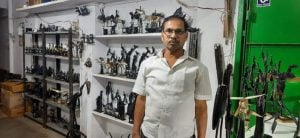Berhampur: The horn craft industry of Paralakhemundi in Gajapati, which was once famous worldwide, is now gasping for survival with the extinct of buffaloes whose horns are used in the craft.
Acclaimed as father of the horn craft in Paralakhemundi, Rao Sahib KV Appa Rao introduced it under the patronage of Maharaja Krishna Chandra Gajapati in early 20th century. Rao, who used to prepare fireworks with a particular variety of horn as containers, used the elasticity of the horns to make beautiful products for daily use as well as decorative pieces.
The average annual turnover of the trade at the time was about Rs 3,000. In 1930, about Rs 1,500 worth of horn products were exported from Paralakhemundi to Tanjore, Coimbatore, Trichinopoly, Madurai and Madras by K Apparao Chetti. During the second world war, hornware of Paralakhemundi was exported to the US and European Countries. The finest horn products were sent to places like Vizianagaram, Kakinada and Rajahmundry.
Generally Europeans and wealthy Indians used to procure the artistic and exquisite horn articles. The horn works of Paralakhemundi got a special place among the works of Kolkata, Punjab, Kakinada and Trivandrum.

Over the years, non-availability of buffalo horns in local market took its toll on the horn craft. The breed of ‘Paralakhemundi buffalo’, whose long horns were used for making the products, has become extinct for 27 years since 1995 due to continued neglect. The average size of horns of ‘Paralakhemundi buffalo’ were 12 to 15 inches compared to 8 to 10 inches of other varieties.
Absence of long-sized horns has forced the local craftsmen to switch over to other varieties of finished horn products. The raw materials which were available in plenty in Gumma, Seranga, Mohana, Rayagada, R Udayagiri and Kasinagar in Gajapati and some tribal pockets in Gunupur decades ago are no more available now. Most of the local craftsmen are procuring a limited amount of horns from Hyderabad with high transport charges.
The black coloured short size horn was available at a price of Rs 25 per kg and white coloured horn Rs 7,00 per kg in 2004. Now, the black coloured horn from Hyderabad costs Rs 300 per kg and the white coloured horn above Rs 1000 per kg, said Prafulla Maharana who is running a horn work shop in the Palace Street Paralakhemundi and is in the profession for the last 41 years.

The number of horn craftsmen in Paralakhemundi has dwindled drastically as they have switched over to other professions for livelihood. While there were around 150 craftsmen 20 years back, their number has come down to 30 now.
Besides, the varieties of horn work artifacts have come down to 40 from 100 during the last 10 years. The horn combs along with crane, shrimp, decorative pieces and others are in great demand. The price of the comb ranges from Rs 40 to Rs 160, while a 3-ft crane costs Rs 3500 and a 4-ft crane Rs 5,500, said Prafulla.
“The horn works are in high demand outside the state. But there is no proper market mechanism in Odisha. We can’t pile up the finished products in the showroom where customers seldom visit by investing all our resources. The only solution is online trading through shopping sites and the district administration must come forward to help the craftsmen in marketing,” said Prafulla.
“As the horn craft faces a gloomy future, I have not forced my two sons to learn the skill,” said Prafulla who is now suffering from heart ailments and regularly visits Visakhapatnam for treatment. Both his sons are now engaged in private firms in Paralakhemundi.


